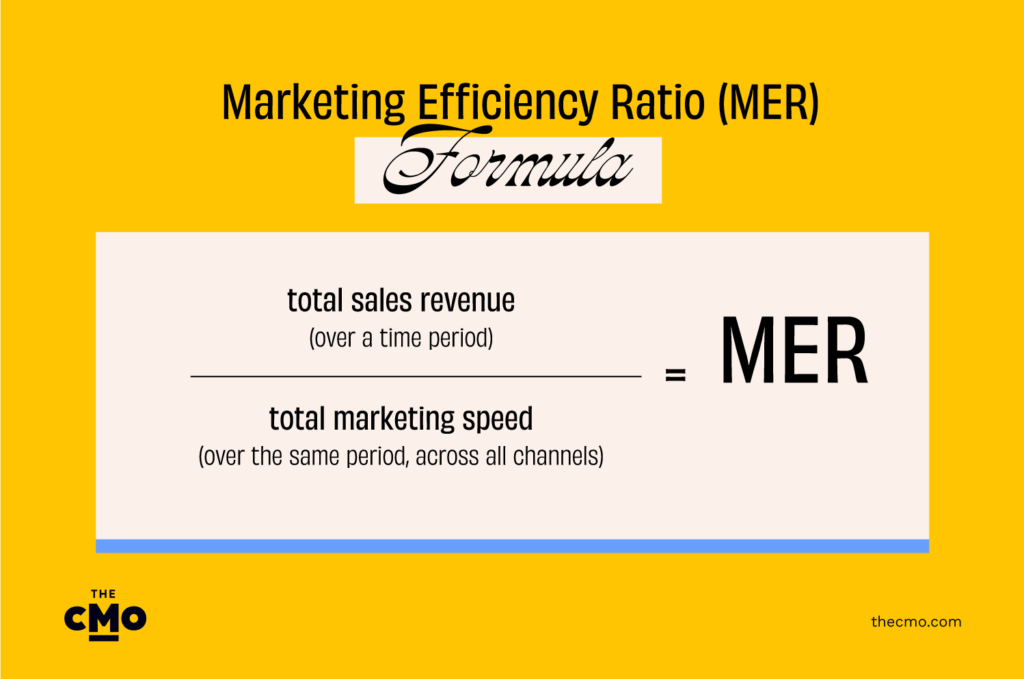Marketing efficiency is a cornerstone for sustainable growth and profitability in business. It's the compass that helps companies steer their marketing efforts in the right direction. But how do you measure the effectiveness of your marketing efforts? This is where an important digital marketing analytics concept comes into play: marketing efficiency ratio (MER).
In this article, I have created a guide on marketing efficiency ratio (MER) that covers what it is, how to calculate it, and why it's crucial for your business success. I have also shared best practices on how to improve your MER ratio.
What Is A Marketing Efficiency Ratio (MER)?
Marketing efficiency ratio (MER) is a metric that calculates the overall impact of your marketing campaigns and is calculated by dividing your total sales revenue by total marketing expenditure (in a given period of time). In simple words, it removes guesswork and tells you how much money your business is making from your marketing efforts.
Other terms used to denote MER are marketing efficiency rating, blended ROAS, ecosystem ROAS or eROAS, and/or media efficiency ratio.
How to Calculate Marketing Efficiency Ratio:
Calculating MER involves assessing the return on investment (ROI) of your marketing campaigns and activities. To calculate MER, follow these steps:
- Determine your marketing spend: Begin by gathering all the costs associated with your marketing efforts. This includes expenses for advertising, promotions, content creation, employee salaries, digital marketing software, and any other resources allocated to marketing.
- Calculate revenue from marketing activities: Calculate the sum of the total revenue generated from marketing activities. This can involve tracking sales originating from specific campaigns. Marketing analytics tools can help you keep track of these numbers.
- Determine the amount of time over which you want to measure: This could be a week, month, quarter, year, or campaign lifetime.
- Compute the marketing efficiency ratio (MER): Divide the revenue or sales generated from marketing efforts by the total marketing costs.
For example, a company spends $5,000 on marketing its products and generates $25,000 in sales.
MER = $25,000 (Total sales/revenue) ÷ $5,000 (Total marketing cost) = 5
In this case, the MER is 5. The company generated $5 in revenue for every $1 spent on marketing. Generally speaking, a marketing efficiency ratio of 5 or above is considered “good.”

Why Is Marketing Efficiency Ratio Important?
If you want to learn how efficiently you are spending your marketing dollars and whether your current marketing strategy is helping you achieve your sales goals, then measuring marketing efficiency ratio (MER) is worthwhile. Let's explore it in more detail:
Helps with Resource Allocation
Effective resource allocation is crucial for any business as it ensures resources are allocated to meet the business outcome. According to McKinsey research, 83% of senior executives believe that resource allocation leads to business growth.
The MER provides a clear picture of which marketing channels or strategies yield the highest return on investment (ROI). This information empowers businesses to allocate their marketing budget to the most productive avenues.
For example, if a company finds that social media advertising has a higher MER than print advertising, it can reallocate funds to social media for better results. This prevents wastage of resources on less effective strategies and maximizes the impact of the marketing budget.
Maximizes Return on Investment (ROI)
Understanding the MER helps evaluate the actual return on investment for marketing efforts. A high MER indicates that the marketing campaign is generating a significant return relative to the cost. This is crucial for profitability and sustainable business growth.
Conversely, a low MER may suggest that a marketing strategy needs adjustment or reevaluation. For instance, if a pay-per-click advertising campaign is not yielding the desired results, the company might need to refine its targeting, ad copy, or landing page to improve the MER.
Enables Performance Evaluation
The MER serves as a performance indicator for marketing efforts. It enables businesses to assess the effectiveness of their campaigns and strategies. By monitoring the MER over time, you can identify trends and patterns in marketing performance.
This data-driven approach facilitates a culture of continuous improvement. If the MER is consistently high, it signals that the marketing team is on the right track. If it's fluctuating or declining, it prompts a closer examination of the strategies in place. This iterative process allows for ongoing refinement and optimization of marketing efforts.
7 Best Practices To Improve Marketing Efficiency Ratio
Improving marketing efficiency ratio is crucial for maximizing the impact of your marketing efforts while minimizing costs. Here are some best practices to improve your marketing efficiency ratio:
1. Set Clear Goals
Begin by defining specific, measurable, and time-bound objectives for your marketing campaigns. Dr. Gail Matthews' study at the Dominican University of California found that research participants who wrote their goals and provided weekly updates successfully achieved their goals compared to their peers who did not write down their goals.
So whether it's increasing website traffic, generating leads, or driving sales, clear goals provide direction and allow you to measure performance accurately. These benchmarks serve as a roadmap, guiding your strategies toward success.
3. Target the Right Audience
Understanding your audience is fundamental to any successful marketing campaign. Tailor your messaging, content, and channels to resonate with your target demographic. This increases the likelihood of engagement and ensures that your resources are invested where they'll have the most impact.
4. Focus on Customer Retention
While acquiring new customers is important, retaining existing ones is equally crucial. A study by Bain & Company, in association with Harvard Business School, found that a 5% increase in customer retention can increase a company’s profits by 25% to 95%.
Loyal customers provide a steady stream of revenue and can also become brand advocates, helping attract new business. So, implement strategies like personalized communication, loyalty programs, and exceptional customer service to foster long-term relationships.
5. Utilize Data and Analytics Tools
Data-driven decision-making is a cornerstone of efficient marketing because it allows businesses to base their strategies and actions on concrete evidence rather than assumptions or intuition. Companies can gain valuable insights into what works and what doesn't by analyzing and interpreting customer behavior, market trends, and campaign performance data. This enables them to allocate resources more effectively, optimize their messaging, and target their audience more precisely. Ultimately, data-driven marketing leads to improved marketing efficiency.
Leverage marketing measurement tools to gain insights into customer behavior, campaign performance, and market trends. This information will enable you to refine your strategies, allocate resources effectively, and identify growth opportunities.
6. Optimize Campaigns
Regularly evaluate the performance of your marketing campaigns. Identify what's working well and what could be improved. Adjust your tactics, messaging, or targeting to optimize results. By fine-tuning your campaigns, you can ensure that resources are allocated to the most effective strategies.
7. Regularly Review and Adapt
The marketing landscape is dynamic, with consumer preferences and trends evolving over time. Regularly review your strategies and adapt to changing circumstances. This might involve exploring new channels, technologies, or approaches to stay ahead of the curve and maintain a competitive edge.
What is the difference between MER and ROAS?
Many people confuse MER with ROAS, but there is a slight difference. As the name suggests, Return on Ad Spend (ROAS) measures revenue earned from total spend on advertising campaigns. It helps identify the effectiveness of your ad campaigns but doesn't look at your overall performance.
On the other hand, MER is a broader metric and shows the overall picture of your marketing campaigns.
MER Vs. ROAS: Which One To Measure?
ROAS is an important metric to measure because it shows how well your ad campaigns perform. However, relying only on ROAS isn't a good idea since it primarily focuses on immediate returns and may not account for the long-term benefits of your advertising efforts. For instance, if you're running a brand awareness campaign, the impact might not be immediately reflected in ROAS, but it can contribute significantly to customer retention and future sales.
ROAS also doesn't consider the customer journey and focuses only on advertising. Imagine you run an ecommerce business that sells high-end outdoor gear, including camping equipment, hiking gear, and adventure apparel. You decide to launch a marketing campaign targeting outdoor enthusiasts.
You employ various strategies in this campaign, including advertising, social media, and content marketing. ROAS would measure the direct return on ad spend for a customer who made a purchase after interacting with specific ads. It would assess the immediate impact of the advertising investment. However, it wouldn't account for the customer's earlier interactions, like reading a blog post or engaging with social media content. This is where MER comes in; it considers the broader marketing value of all content and customer touchpoints.
That said, it doesn't mean you should only use MER and not look at ROAS at all. By utilizing both metrics, you ensure a well-rounded understanding of the impact and efficiency of your advertising efforts.
Example Of Marketing Efficiency Ratio
Let’s take the (fictional) example of Brew Culture Coffee Roastery and calculate its MER.
Brew Culture is a specialty coffee roastery that prides itself on sourcing and roasting the finest coffee beans worldwide. They launched a marketing campaign to introduce their limited-edition coffee collection. Here's a breakdown of their campaign:
- Total ad spend: $8,000 for online advertising on platforms like Google Ads and social media
- Content creation and distribution: $1,500 for creating website content and social media posts via various digital marketing platforms
- Email marketing campaign: $1,200 for running email marketing campaign
- Salaries and technology costs: $10,000 for salaries of their marketing team members, as well as software and tools for email marketing and website analytics
Now, let's calculate the MER:
Total Marketing Expenses = Advertising Spend + Content Creation + Email Marketing + Salaries & Technology Costs
Total Marketing Expenses = $8,000 + $1,500 + $1,200 + $10,000 = $20,700
Let's assume the company generates $30,500 in revenue from these combined efforts.
MER = Revenue Generated ÷ Total Marketing Expenses
MER = $30,500 / $20,700 ≈ 1.47
In this fictional example, Brew Culture has an MER of approximately 1.47. 1.47 is quite a bit below the target MER of 5+ so Brew Culture Coffee Roastery should consider revisiting their marketing strategy. They might decide to cut back on ad spending, leverage more “free” content (like incentivizing customer reviews and shares), or spend some time repurposing the marketing content they already have to see how they can improve their results.
Conclusion
As I wrap up this article, remember that achieving an optimal marketing efficiency ratio (MER) is a dynamic process that requires continuous monitoring and adjustment. Don’t be discouraged if your current ratio doesn’t meet the industry benchmarks—use it as a starting point for improvement. You can achieve a higher marketing efficiency ratio by closely monitoring your expenses and returns and employing data-driven strategies.
If you’d like to learn about other marketing topics or want insights from the best marketing experts, check out our article on cost per mille and subscribe to The CMO newsletter.


